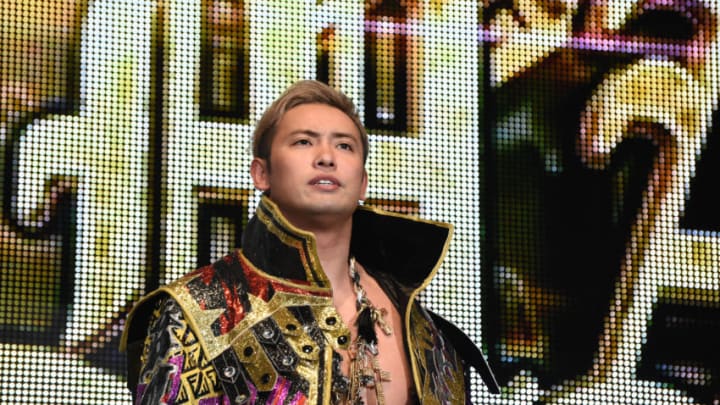【いよいよメインイベント! オカダ・カズチカがMSGに降らせるカネの雨!】
— 新日本プロレスリング株式会社 (@njpw1972) April 7, 2019
4.6マディソン・スクエア・ガーデン大会をニューヨークから生中継!
☆視聴&登録は⇒https://t.co/Mps1PBMkVR#G1SuperCard #NJPW #ROH #njpwworld pic.twitter.com/bXZZlT7Yhk
NJPW Delivers the Perfect Ending for G1 Supercard
Perhaps the greatest example of NJPW’s willingness to play the long game is shown by their IWGP Heavyweight Championship match at G1 Supercard. Look no further than Kazuchika Okada, the challenger going into the night. If you go all the way back to the beginning of Okada’s career, you see a young talent who spent a few years at the NJPW Dojo and was sent on excursion to grow as a competitor outside of NJPW, a common practice for the promotion.
Okada went to TNA Wrestling, and proceeded to have an abysmal time there working as a character that was essentially a “Green Hornet knockoff.” The poor execution of Okada’s tenure in TNA Wrestling was even reportedly part of the reason NJPW stopping working with the company, later partnering with ROH who they still work with today. Considering how things went with TNA Wrestling, you might expect Kazuchika Okada to be put on the backburner upon his return.
This was not the case. He defeated Yoshi-Hashi in his return to NJPW in 2012 and immediately challenged IWGP Heavyweight Champion Hiroshi Tanahashi. One month after his return, Kazuchika Okada captured the IWGP Heavyweight Championship for the first time. NJPW clearly had a plan, and they weren’t about to let anything change it. Of course, the decision has since proven to be the right one.
Kazuchika Okada went on to become a 4-time IWGP Heavyweight Champion, even holding the title for a record-shattering 720 days from June 2016 to June 2018. He’s also proven to be one of the greatest competitors in the industry, being recognized as a top star or for having top matches several times by Tokyo Sports, Pro Wrestling Illustrated, Wrestling Observer Newsletter, and Nikkan Sports.
His opponent at G1 Supercard, Jay White, has had a strikingly similar rise. Jay White entered the NJPW Dojo in early 2015. After a year and a half working as a young lion, proving himself and continuing to learn, he went on excursion to ROH. While he did continue to grow during his absence, White failed to really make a name for himself during his absence. Once he returned to NJPW in late 2017, he was a completely different person.
Taking on the moniker “Switchblade,” White immediately positioned himself against IWGP Intercontinental Champion Hiroshi Tanahashi. Despite a valiant effort, White came up short against Tanahashi at Wrestle Kingdom 12. He continued to grow as a competitor throughout the year, capturing the IWGP United States Title by defeating Kenny Omega. At that year’s G1 Climax tournament, White also picked up noteworthy victories over both Kazuchika Okada and Hiroshi Tanahashi, despite not winning the tournament.
After working his way up the ranks, and joining forces with Okada’s longtime manager Gedo, Jay White found himself in position to challenge IWGP Heavyweight Champion Hiroshi Tanahashi two months ago at The New Beginning in Osaka. In a moment as shocking as Okada’s capture of the title in 2012, White emerged victorious as the new champion.
All of this brought us to G1 Supercard, where NJPW took two long-term storylines and brought them together. Okada, who had yet to beat Jay White in singles competition, was looking to recapture his title, while White was struggling to prove himself as champion. They gave us a clinic that lasted over half an hour, and capped off the night with Kazuchika Okada finally taking down “Switchblade” Jay White, fighting through interference by Gedo, to become IWGP Heavyweight Champion once again.
With his capture of the title against Hiroshi Tanahashi and his rise to that position, Jay White has proven himself and already been solidified as a future face of the company. However, at the biggest US-based show in NJPW history, it was only right that the biggest name in the company and their true top star right now leave with their top championship.
It capped off the night in the perfect way, and really drove home the comparison between ROH and NJPW. Whereas Taven had felt like a forced choice to lead the company, Jay White was legitimized even in failure, and NJPW completed Okada’s return to prominence. The unfortunate message coming out of G1 Supercard was that NJPW was far superior to ROH, and it leaves the partnership between the two companies in question.
If ROH is going to continue to make poor decisions, even at the biggest event in their company’s history, is the relationship between NJPW and ROH really beneficial to New Japan anymore? With All Elite Wrestling on the rise, potentially with Marty Scurll added to their roster if he leaves ROH when his contract expires, should NJPW reevaluate things?
These are big questions that don’t have easy answers, but Ring of Honor didn’t do themselves any favors last night. At every turn, they stepped on their own potential and seemed to hamper their own success. Meanwhile, NJPW did what they always do. They stuck to the plan, and it went perfectly.
